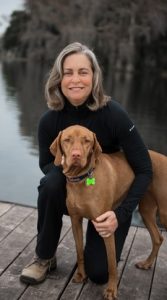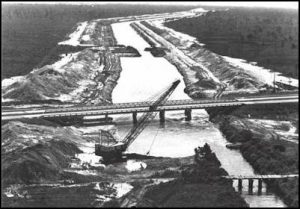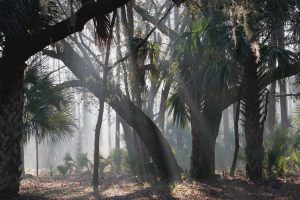Leslie Poole
Assistant Professor of Environmental Studies at Rollins College
B.S. Journalism 1978, Ph.D. History 2012
 The spirit of conservation is borne from a connection to a place. Leslie Kemp Poole is a fourth-generation Floridian, with deep familial ties to the state and deep emotional ties to its history and natural beauty. History is her trade, and the lens by which she views and tells and teaches Florida’s story, and her work, is as personal as it is professional.
The spirit of conservation is borne from a connection to a place. Leslie Kemp Poole is a fourth-generation Floridian, with deep familial ties to the state and deep emotional ties to its history and natural beauty. History is her trade, and the lens by which she views and tells and teaches Florida’s story, and her work, is as personal as it is professional.
Poole is the author of two books, Maitland, a history of the small Central Florida town, and Saving Florida: Women’s Fight for the Environment in the 21st Century, a chronicle of the unique role women have played as leaders in Florida’s environmental political and conservationist movement.
Her work as a reporter for the Orlando Sentinel covering Florida’s lack of growth management was nominated for a Pulitzer Prize.
What inspired you to devote so much of your career to natural Florida, and what keeps you at it decades later despite the ecological loss you’ve seen in that time?
As a fourth-generation Floridian, it is impossible for me to ignore the loss of our natural beauty and resources, which occupy a piece of my very being. At the same time, I’ve seen remarkable things happen—people rallying to protect a river, green space purchased for future generations by the nation’s largest land buying program, and endangered species making a comeback thanks to protective laws and dedicated activists.
So, I know things can change. I want to be a part of that. And when I get really sad about some new ecological problem, I put on my hiking boots or get into a kayak and surround myself with the beauty that still exists in order to refresh my soul.
What’s your favorite story of how journalism or communications, your work or someone else’s, made a difference on behalf of Florida’s environment?
There are a lot of stories about how the media has made a difference. A social media campaign to save an ancient live oak and park in downtown Orlando. A publicized rally to save state parks from becoming golf courses and cattle ranges.
 But my favorite story is that of the Cross Florida Barge Canal, Florida’s first grassroots environmental victory. The work of a group of dedicated academics, activists, and citizens in the 1960s stopped an enormous federal works project boondoggle from being completed—a project that might have damaged the Floridan Aquifer and would have caused enormous environmental damage to natural resources.
But my favorite story is that of the Cross Florida Barge Canal, Florida’s first grassroots environmental victory. The work of a group of dedicated academics, activists, and citizens in the 1960s stopped an enormous federal works project boondoggle from being completed—a project that might have damaged the Floridan Aquifer and would have caused enormous environmental damage to natural resources.
The anti-canal group, initially laughed at and ignored by bureaucrats and reporters, worked to change the minds of newspapers, which initially supported the canal. When confronted by irrefutable facts, the media shifted its opinion of the project and in doing so helped sway public and political opinions. That helped lead to the demise of the project in 1971. Now, if we could only get public opinion firmly set on restoring the damage that was incurred….
What’s the most critical environmental threat facing Florida, and the most meaningful action the state and its citizens can do to help?
I think there are three major threats facing Florida: climate change, water (quality and quantity), and political bias against the environment. Climate change and sea-level rise may destroy some of the most beautiful places in Florida, including the Everglades and Florida Keys, and endanger many residents; the availability and quality of water may lead to major fights among urban areas, leaving natural areas high and dry; and politics has already destroyed the agencies that were meant to protect our natural resources and guide sensible growth.
The most important thing citizens can do is VOTE and be active in campaigns. Let state leaders know that these are critical issues that can determine an election outcome. Mean it and do it!
What is your favorite spot in Florida to embrace its ecological wonders?
 It’s hard to beat a long hike in the beautiful longleaf pine stands at Goethe State Forest on a cold, clear winter day. I rarely ever encounter any people other than my hiking pals in its 53,000 acres. And listening to the sound of wind in the pine needles—and no other sound—is magical. If I’m lucky, I’ll encounter some endangered red-cockaded woodpeckers and my day will be complete. Most of the southeastern United States was once covered in longleaf habitat, but only 3 percent remains today although there are efforts to try to restore these important ecosystems.
It’s hard to beat a long hike in the beautiful longleaf pine stands at Goethe State Forest on a cold, clear winter day. I rarely ever encounter any people other than my hiking pals in its 53,000 acres. And listening to the sound of wind in the pine needles—and no other sound—is magical. If I’m lucky, I’ll encounter some endangered red-cockaded woodpeckers and my day will be complete. Most of the southeastern United States was once covered in longleaf habitat, but only 3 percent remains today although there are efforts to try to restore these important ecosystems.
What would you advise current CJC students about how/whether their work may help protect Florida’s wild lands, waters and creatures — and all of us?
You are the future. You are the means by which to provide information and create awareness about Florida’s natural beauty and resources. Use your talents while honing your writing and social media skills and get out there and make a difference! Science and research are important but if people don’t understand them, they hold no power. Use your CJC training to interpret these findings, engage the public, and show where/how change can occur. I’m counting on you.
